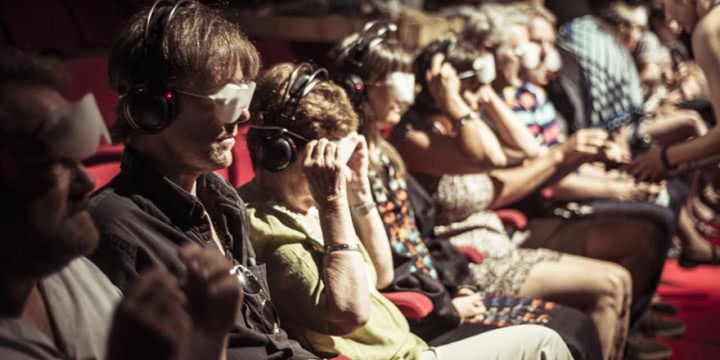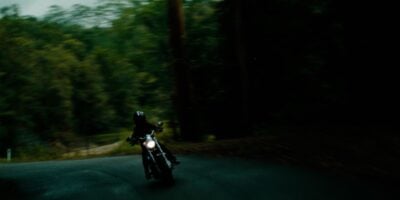Close your eyes. Cover your ears. Walk through your house.
Now imagine for a moment that you’re outside, crossing a street, boarding a plane, ordering from a menu.
That’s the life that performer Heather Lawson and pianist Michelle Stevens have lived for decades. Stevens was born without sight, and Lawson without sound – over time, they both became deaf-blind. Their experience is now being brought to Sydney Festival audiences in Imagined Touch under the guidance of director Jodee Mundy, herself the only hearing member in a deaf family.
“I didn’t realise my family were deaf until I was six years old,” says Mundy. “The way I found out is I got lost in Kmart, and a lady made an announcement on the microphone. It was quite a shock, because I knew that my family were deaf but I didn’t know it meant they couldn’t hear. Now, that’s very distinctive. I suddenly realised I had access to all these things that my family didn’t, from television – I mean, subtitles weren’t on television back then. I answered the phone, I answered the door and people treated my family like – because they didn’t talk or they didn’t speak – that they were less.”
Mundy, whose first language was Auslan (Australian sign language), believes she has never fully recovered from that first transition into the hearing world, and it drives much of her engagement with the arts. “I want to bring audiences into this world and show them how amazing it is, how rich and how inclusive our world is, and how exclusive the world of people who are mainstream is,” she says.
Sydney Festival marks the second production of Imagined Touch, a work five years in development, which combines live art, theatre, installation and sensory performance to immerse audiences in the experience of living without sight or sound.
“This work is an invitation for people to rethink about what it means to be a human being and how to navigate the world,” says Mundy. “We’re so reliant on our eyes and ears, especially in the 21st century, so this is a chance for people to see Heather and Michelle as deaf-blind but also as experts of touch and tactile communication.”
Naturally, as the work involves touch to communicate, it is an intimate participatory experience. For some audiences, comfortable in their seats, that may be somewhat confronting. “The barriers would be [that] people are afraid, and fair enough!” laughs Mundy. “This is something that Heather and Michelle have had to overcome – their sense of fear. You know, they catch trains, buses and planes by themselves … They really want audiences to understand the profound isolation and the grief and the fear that they’ve had to overcome, but also the beauty of what it means to meet someone through touch.
“When you meet someone through touch, you don’t know what skin colour they are – sometimes you don’t even know if they’re a man or they’re a woman – but what matters is a kind hand. So if there’s a barrier for an audience and they’re afraid, it’s about trust. This whole work is about trust; it’s a call-out to trust and about reconnecting as people.

Imagined Touch is incredibly rare as a work featuring deaf-blind performers – its only real overseas equivalents come from the Nalaga’at company, whose Not By Bread Alone sees deaf-blind performers make bread for the audience. Mundy’s experience of that work impacted her development.
“They’ve got 12 in their ensemble and it’s also performed in front of about 500 people. It’s a big spectacle show. This is the opposite; it’s a very intimate experience. We believed that Heather and Michelle needed to know who their audience were and for them to be connected to their audience at all times, and through the mode of touch because that is their world.”
Mundy’s optimism is fuelled by both passion and pragmatism: Imagined Touch is enormously ambitious, but it paves the way for even more daring works by performers with disabilities. She believes the show is as much about proving it can be done, and showing the process, as it is staging it.
“The presence of performers with a disability in the arts has been a long battle,” she says. “It’s been a good 40 years since the disability movement has been going and as someone who grew up in a community that’s perceived to have disability, it’s a life work. We never thought we’d make it to Sydney Festival.”
Mostly this comes down to the sheer amount of resources required, even for so intimate a show. But Mundy’s strength is in understanding the returns. “Heather and Michelle need two interpreters each just to be able to be part of a conversation. So that’s four interpreters – that’s $200 an hour just to be able to talk to them.
“But the thing for artists with disabilities is so much is quantified through economic terms, but what we’re not quantifying is the loss of quality of life. [For] Heather and Michelle, this is one project … so for us to have that one project … what it means for us is hope in fellow human beings, hope that social change is a real thing.
“It’s proving to me that inclusion is not amiss,” Mundy continues. “Real inclusion means sharing and that means everyone, every single one of us, hands over a little bit of power to make space for people who are disempowered. So this is proving to us that things are possible, that people are listening, that people do care, and that Heather and Michelle’s stories are worth their weight in gold.”
[Imagined Touch photo [top] by Pippa Dodds / Imagined Touch photo [right] by Jeff Busby]
Imagined Touch, as part of Sydney Festival 2017, runsMonday January 9 – Saturday January 14 at Carriageworks.

































